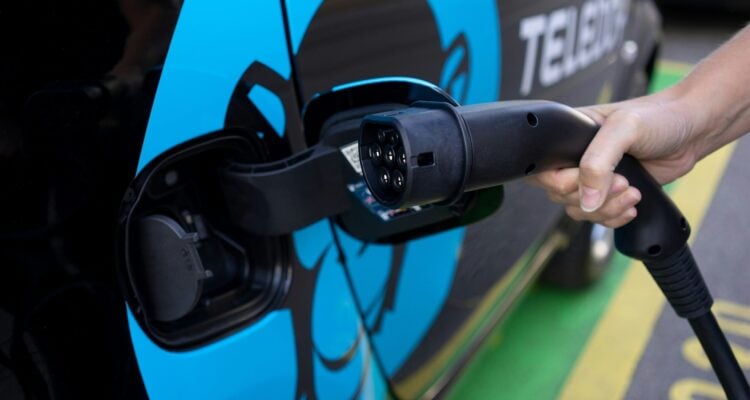Zapmap, the UK’s leading charge point mapping service, has published new statistics showing that the country has surpassed 75,000 public charge points. Zapmap data for the state of the public charging infrastructure shows that, as at the end of February, there are 75,675 charge points in the UK, representing a 32% year-on-year increase compared to February 2024, when 57,290 devices were recorded.
Operated by Ionity, the 75,000th public charge point is one of eight ultra-rapid and four rapid devices installed at the Village Hotel, Bristol. With each ultra-rapid device delivering up to 350 kW of power, the site is in close proximity to the M4, M5 and M32 motorways and easily accessible for electric vehicle (EV) drivers looking for en-route charging. At the same time, the location provides a destination in its own right, providing hotel facilities, a gym, pool, co-working spaces, Starbucks and a Pub & Grill.
Ionity is also a Zap-Pay partner, meaning that EV drivers using its charge points can pay quickly and easily using Zapmap’s in-app payment solution, avoiding the hassle of using different payment methods across the various charging networks.
The 75,000th charging device reflects the encouraging growth of the country’s charge point infrastructure. 2024 saw a record rate of charge point installation with particularly strong growth in the ultra-rapid segment (150kW+), which has seen an increase of 74% in installations since the end of February 2024.
While ultra-rapid growth has been particularly strong, the public charging infrastructure has seen growth across all charging use cases, from en-route charging for longer journeys, charging provision at destinations such as hotels and leisure centres, as well as lower-powered charge points on residential streets for drivers unable to charge at home.
Looking forward, assuming that the ZEV mandate regulations are not watered, it is expected that the EV infrastructure will continue to see strong growth. As projects funded by LEVI (Local Electric Vehicle Infrastructure) come to fruition, a high number of on-street chargers will be rolled out through the second half of the year, with numbers being further bolstered by investment from the private sector. With increased focus from charge point operators on reliability and simplified payment, we can expect to see continued improvements to the overall EV driver experience.
Melanie Shufflebotham, Co-founder & COO at Zapmap, said: “Having 75,000 public charge points available, across the different charging use cases, is a significant milestone for the UK EV market.
“An extensive network of public charging, especially high visibility hubs, helps drive confidence for the next wave of drivers who will be making the switch to electric over the next few years.
“As the infrastructure continues to grow, Zapmap’s focus is to make sure that EV drivers have access to the best up-to-date information so they can find and pay for public charging with confidence.”
Vicky Read, CEO at ChargeUK said: “Reaching 75,000 public charge points is a significant milestone and an incredible achievement for an industry that is barely a decade old.
“We know a successful transition to EVs depends on world-class charging infrastructure being deployed ahead of demand. Today’s announcement is yet more proof that ChargeUK’s members are getting on with the job, with the public network having grown by 37% in 2024.
“But now is not the time for complacency. Millions more EVs will be sold in the coming years, so we need to keep the momentum going with ChargeUK’s members having committed to invest £6 billion by 2030 to do just this.
“Though translating investment into chargers requires a supportive policy environment. That means a strong and stable ZEV mandate and positive steps to address barriers to affordability and deployment, such as equalising VAT, a solution to rising standing charges, and the speeding up of grid connections.”
Andreas Atkins, Country Manager, UK & Ireland, Ionity, said: “It’s been a real personal pleasure to see IONITY’s UK network grow, and the region become a real success story for EV infrastructure in Europe. We’ve doubled the number of chargers available in the UK year-on-year in the past two years, including our largest site in the UK at Dartford, and that’s come as part of a huge push alongside other CPOs right across the country to accommodate every kind of transport.”
“That these chargers are available through a consolidated hub like Zapmap, informing and educating road users, is huge for normalising EV travel. For the UK to have reached 75,000 is incontrovertible evidence, even in an uncertain political climate, that sustainable transport in the UK is here to stay — and to grow!”
Kelli Turner, General Counsel / Director of ESG, Village Hotel Club, said: “The UK’s shift to a greener future requires action from all. At Village, we’re proud to play a role in supporting this shift through the installation of ultra-rapid chargers across our estate. This not only allows electric vehicle users to charge much faster than a standard charger, but also has the added convenience of allowing visitors to charge while at their local Village Gym, using our coworking space VWorks, or just popping in for a coffee at an onsite Starbucks.”
Asif Ghafoor, CEO of national EV charging network Be.EV, said: “This milestone is a cause for celebration and helps to prove that the narrative surrounding range anxiety is nonsense. I regularly travel to EV charging sites all across the country and I’ve seen hardly any queues. There’s clearly enough infrastructure out there for EV drivers at the moment, and we’re well on track to keep pace with demand.
“What’s been particularly encouraging has been the growth in rapid/ultra-rapid chargers, which increased by 84% last year. When we started the roll-out, there was far too much of an obsession with lamppost chargers.
“They’re handy for people who need to charge overnight but they’re rubbish for everything else and there’s too many of them. Many of these chargers don’t have contactless payments and are installed with little thought for accessibility. Cheap lamppost chargers are not the best solution for everyone, and many will be nothing but street litter in a few years’ time given how quickly batteries are improving. However, the kit has come a long way, and there’s more of a focus now on putting ultra-rapid chargers in the ground, which are the chargers drivers actually want to use.
“What we need now is to upgrade the old chargers that are giving the industry a bad rep. Charging providers have a responsibility to make sure chargers are upgraded and suit what drivers want today, not what they wanted three years ago. For example, contactless should be a given at all chargers, which it isn’t currently. This will greatly improve the driver experience and give non-EV drivers yet another reason to make the switch.
“We also need more signposting on roads and motorways, which will help to bring an end to the outdated reliance on chargers at motorway service stations. Many drivers use their car or apps for this, but signposting will help drive behaviour change and encourage drivers to find better EV charging hubs outside of where they used to refuel. Many are located less than ten minutes away from motorways, where the chargers are less busy (and the food and drink is cheaper).
“What we need to challenge is the perception of poor range. It’s clear that there are more than enough chargers, we just need to do a better job of letting drivers know that this is the case. Signs that actually tell them where these chargers are would go a long way.”




















